Howdy, BugFans,
It’s High Summer, and a lot has been going on out there. Many species have already peaked and disappeared from the scene, assuming, until next year, whatever form they spend the majority of their lives in. Others are coming into their own. Here are some of the sights the BugLady has seen in local prairies and wetlands.
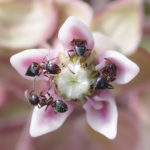 ANTS are everywhere, foraging for proteins and carbs, including milkweed nectar to take home to their families. Some species of ants have workers that are essentially tanker trucks. Ants are no great shakes as pollinators, due to their slippery little bodies and fastidious grooming habits, and besides that, they’re pedestrians, so the pollen doesn’t travel far. (Family Formicidae)
ANTS are everywhere, foraging for proteins and carbs, including milkweed nectar to take home to their families. Some species of ants have workers that are essentially tanker trucks. Ants are no great shakes as pollinators, due to their slippery little bodies and fastidious grooming habits, and besides that, they’re pedestrians, so the pollen doesn’t travel far. (Family Formicidae)
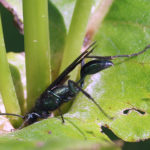 BLUE MUD DAUBER WASP – Cup plants have “perfoliate” leaves that look like two “conjoined leaves” but are actually a single leaf whose base is joined around the stem, making it look like the stem is piercing it. For a few days after a rain, reservoirs made by the cup plant’s leaves hold water that’s appreciated by all sorts of small animals. The wasp uses mud to construct chambers for her eggs, but she doesn’t carry water to dirt, spit on it, and stir. She may just be thirsty. (Family Sphecidae)
BLUE MUD DAUBER WASP – Cup plants have “perfoliate” leaves that look like two “conjoined leaves” but are actually a single leaf whose base is joined around the stem, making it look like the stem is piercing it. For a few days after a rain, reservoirs made by the cup plant’s leaves hold water that’s appreciated by all sorts of small animals. The wasp uses mud to construct chambers for her eggs, but she doesn’t carry water to dirt, spit on it, and stir. She may just be thirsty. (Family Sphecidae)
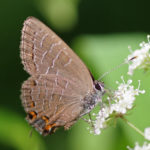 STRIPED HAIRSTREAK – The BugLady found this small butterfly of dappled woods and edges while she was surveying water hemlock plants for an up-coming episode. Adults nectar on available flowers, and Butterflies of the Great Lakes Region tells us that “Early in the morning, they will sip dew from leaves as they bask.” They’re not-very-common – “scattered lightly over our landscape,” says “The Butterflies of Massachusetts” website, “widely distributed although nowhere abundant.” The theory is that the eyespots on the hind wing confuse predators. (Family Lycaenidae)
STRIPED HAIRSTREAK – The BugLady found this small butterfly of dappled woods and edges while she was surveying water hemlock plants for an up-coming episode. Adults nectar on available flowers, and Butterflies of the Great Lakes Region tells us that “Early in the morning, they will sip dew from leaves as they bask.” They’re not-very-common – “scattered lightly over our landscape,” says “The Butterflies of Massachusetts” website, “widely distributed although nowhere abundant.” The theory is that the eyespots on the hind wing confuse predators. (Family Lycaenidae)
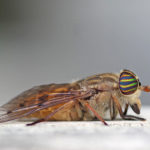 HORSEFLY – Just a glamour shot of a horse fly, that’s all. (Family Tabanidae)
HORSEFLY – Just a glamour shot of a horse fly, that’s all. (Family Tabanidae)
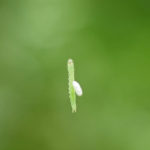 PARASITIZED – This dangling caterpillar was discovered in its infancy by a small, parasitic wasp that laid an egg in it. The wasp larva hatched, and then it ate and grew within the caterpillar, which was trying to do the same, but whose existence had been repurposed. When it was ready to pupate, the wasp dealt the coup de grace to its unfortunate host, exited, and spun a cocoon on the outside. As Darwin once said of parasitoids, “I cannot persuade myself that a beneficent and omnipotent God would have designedly created the Ichneumonidae with the express intention of their feeding within the living bodies of Caterpillars.”
PARASITIZED – This dangling caterpillar was discovered in its infancy by a small, parasitic wasp that laid an egg in it. The wasp larva hatched, and then it ate and grew within the caterpillar, which was trying to do the same, but whose existence had been repurposed. When it was ready to pupate, the wasp dealt the coup de grace to its unfortunate host, exited, and spun a cocoon on the outside. As Darwin once said of parasitoids, “I cannot persuade myself that a beneficent and omnipotent God would have designedly created the Ichneumonidae with the express intention of their feeding within the living bodies of Caterpillars.”
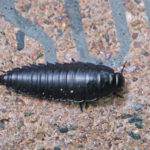 AMERICAN CARRION BEETLE – The BugLady has seen a number of adult carrion beetles flying around –black and yellow and big and buzzy – trying to convince her that they’re bumble bees, but she rarely sees the larvae. Adults lay their eggs on dead animals, and then stick around on the carcass doing “pest control” (eating the competition) before their well-armored larvae hatch and for a while afterward. The larvae will also eat other larvae they find on “their” carrion. (Family Silphidae)
AMERICAN CARRION BEETLE – The BugLady has seen a number of adult carrion beetles flying around –black and yellow and big and buzzy – trying to convince her that they’re bumble bees, but she rarely sees the larvae. Adults lay their eggs on dead animals, and then stick around on the carcass doing “pest control” (eating the competition) before their well-armored larvae hatch and for a while afterward. The larvae will also eat other larvae they find on “their” carrion. (Family Silphidae)
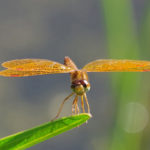 EASTERN AMBERWING – The BugLady’s favorite insect is the Tiger Swallowtail, but the Eastern Amberwing is on her long list of second-favorites. This feisty 0.9” dragonfly has an attitude way bigger than its size. (Family Libellulidae)
EASTERN AMBERWING – The BugLady’s favorite insect is the Tiger Swallowtail, but the Eastern Amberwing is on her long list of second-favorites. This feisty 0.9” dragonfly has an attitude way bigger than its size. (Family Libellulidae)
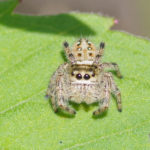 A JUMPING SPIDER in the genus Pelegrina (thanks as always for the ID, BugFan Mike) is another critter with attitude. You can see why jumping spiders have fan clubs. (Family Salticidae)
A JUMPING SPIDER in the genus Pelegrina (thanks as always for the ID, BugFan Mike) is another critter with attitude. You can see why jumping spiders have fan clubs. (Family Salticidae)
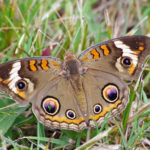 COMMON BUCKEYE – The BugLady has way more shots of this beautiful butterfly sitting on the ground than on flowers (when it sits on flowers, it prefers composites); it typically flits along 6’ ahead of her on mowed paths. It’s a Southern migrant to God’s Country, arriving in early summer, but the migrants produce a brood once they’re here. The undersides of the wings of the migrants and the later/fall broods are different – if you’re lucky enough to see one with its wings closed. If the Striped Hairstreak’s eyespots are meant to confuse, the Buckeye’s are meant to intimidate. (Family Nymphalidae)
COMMON BUCKEYE – The BugLady has way more shots of this beautiful butterfly sitting on the ground than on flowers (when it sits on flowers, it prefers composites); it typically flits along 6’ ahead of her on mowed paths. It’s a Southern migrant to God’s Country, arriving in early summer, but the migrants produce a brood once they’re here. The undersides of the wings of the migrants and the later/fall broods are different – if you’re lucky enough to see one with its wings closed. If the Striped Hairstreak’s eyespots are meant to confuse, the Buckeye’s are meant to intimidate. (Family Nymphalidae)
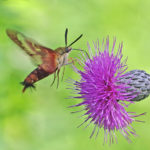 CINNAMON CLEARWING MOTH – So cool! So speedy! Clearwing moths are in the Sphinx moth family Sphingidae; we have two species around here, and the BugLady has plenty of out-of-focus shots of each. Like chasing sprites.
CINNAMON CLEARWING MOTH – So cool! So speedy! Clearwing moths are in the Sphinx moth family Sphingidae; we have two species around here, and the BugLady has plenty of out-of-focus shots of each. Like chasing sprites.
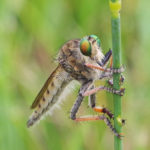 ROBBER FLY – Some robber flies are small and shy, but Promachus vertebratus is neither. At about an inch long, it was almost the same size as the Halloween Pennant dragonflies the BugLady was photographing at the same time. It makes “annoyed” sounds when you kick it up in the fields (attitude again). These flies prey on anything they can catch – the BugLady has a shot of one holding a Clouded Sulphur butterfly. (Family Asilidae)
ROBBER FLY – Some robber flies are small and shy, but Promachus vertebratus is neither. At about an inch long, it was almost the same size as the Halloween Pennant dragonflies the BugLady was photographing at the same time. It makes “annoyed” sounds when you kick it up in the fields (attitude again). These flies prey on anything they can catch – the BugLady has a shot of one holding a Clouded Sulphur butterfly. (Family Asilidae)
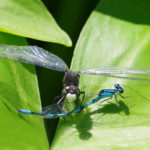 WHITEFACE AND BLUET – The BugLady was stalking dragonflies at Spruce Lake Bog when a Dot-tailed Whiteface dragonfly grabbed a Marsh Bluet damselfly and sat down beside her. Something buzzed the duo loudly – maybe a robber fly – and the startled dragonfly released its prey. As the whiteface moved to a different perch, the damselfly shook it off and flew away. No damselflies were harmed to make this picture. (Families Libellulidae and Coenagrionidae)
WHITEFACE AND BLUET – The BugLady was stalking dragonflies at Spruce Lake Bog when a Dot-tailed Whiteface dragonfly grabbed a Marsh Bluet damselfly and sat down beside her. Something buzzed the duo loudly – maybe a robber fly – and the startled dragonfly released its prey. As the whiteface moved to a different perch, the damselfly shook it off and flew away. No damselflies were harmed to make this picture. (Families Libellulidae and Coenagrionidae)
Go outside – look at bugs!
The BugLady